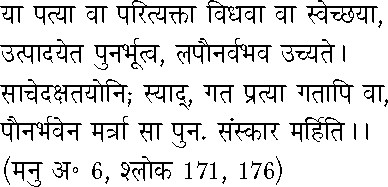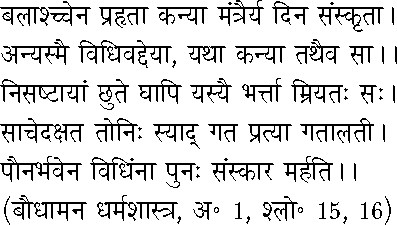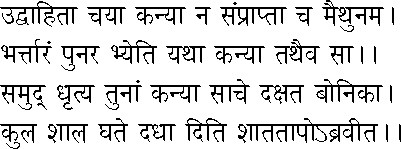Extract from Hindu Sangathan: Saviour of the Dying Race7
The Hindu Sabha has also resolved that those non-Hindus who have faith in Hindu Samskars and Hindu Dharma should be taken within the fold of the Hindu Dharma. This means that every non-Hindu has a right to be absorbed in Hinduism if he has faith in the Hindu religion and culture, in short it means that every Christian, Muhammadan, Jew & c., can be converted to the Hindu Dharma without any hindrance according to the dictum of the Hindu Mahasabha. Thus moral sanction of the Hindu community as a whole is with the reformers in this respect. But the task is uphill. Without sufficient funds and enthusiastic workers the work is languishing. Therefore, the first remedy is to make the Bhartiya Hindu Shuddhi Sabha a living body, to collect lakhs of rupees for pushing on work in all directions and to induce selfless men of pure intents to go about persuading Hindus to take back to their bosom their strayed brethren.
The second remedy is to revivify the ancient Ashram Dharma and to place it on a sound basis. The Hindu Sabha has laid down the minimum marriageable age at 18 years in the case of males and of 12 years in the case of girls. This reform by doles won’t do. Let the minimum marriageable age be fixed at 25 for males and 16 for females and let Hindu society become strict in the enforcement of this scientific rule. Then no widower of the three higher Varnas ought to be allowed to marry a virgin. If, after the death of the first wife, the widower cannot lead a life of Brahmacharya let him marry a widow. If he is compelled to succumb to animal passions let him climb down to the position of a Shudra. Then, polygamy in the North and polyandry in the South should also be unequivocally condemned. And in order to protect and educate Hindus properly separate Gurukulas for boys and girls ought to be opened in all parts of the country.
But the Hindu Samaj has already sinned for more them ten centuries by introducing child marriage for its cowardly safety.
Therefore—The third remedy lies in allowing all the unconsummated child widows, who have the desire, to remarry. It is only
Apaddharma  If a Hindu commits a sin or neglects to act according to a virtuous dictum he must expiate for it. Proper prayashchit alone
can wash away the fruits of a sin in the case of individuals as well as of nations. The orthodox Hindu professes to believe
in the Vedas, the Smritis as well as the Puranas. The Vedas lay down the Eternal Dharma which is true for all ages. The Veda
is the original source of Dharma.
If a Hindu commits a sin or neglects to act according to a virtuous dictum he must expiate for it. Proper prayashchit alone
can wash away the fruits of a sin in the case of individuals as well as of nations. The orthodox Hindu professes to believe
in the Vedas, the Smritis as well as the Puranas. The Vedas lay down the Eternal Dharma which is true for all ages. The Veda
is the original source of Dharma.

But the Smritis, which are not opposed to the teachings of the Vedas, should also be followed. These Smritis lay down the
rules to be followed in times of extreme distress or calamity and such rules constitute what is called  Apaddharma.
Apaddharma.
Apart from the Vedas, there is a consensus of authority, in the Smritis, sanctioning the remarriage of unconsummated child widows. The Smritis also hold that if a virgin is forcibly carried away and violated she does not lose the position of a virgin if she has not willingly gone through marriage rites with her ravisher. Out of a hundred or more Smriti texts the following few will suffice to prove the position I have taken up:

If a woman abandoned by her husband or a widow having accepted another as a husband begets a child, it is named Punurbhu. If that woman has not been consummated by the first husband she can be legally married to a second husband.

A woman whose marriage rites alone are performed—whether she is a virgin or an unconsummated widow—is called first Punurbhu and is fit to be legally married.

If the husband of a married girl dies at the end of the marriage Samskar and she is unconsummated she is entitled to be married again.

(i) If a girl has been forcibly carried away and her marriage has not been lawfully performed she can be married to another according to law because she is like a virgin.
(ii) And one whose husband dies after marriage and she is un-consummated—even if she has been to her husband’s home—is fit to be lawfully married a second time.

A girl who has been married but remains unconsummated can again be given to a second husband because she is like a virgin.
That girl, if she is unconsummated, can be given in marriage to a man of character belonging to a noble family—so says Shatatap.
The fourth remedy lies in the revival of Varnadharma of the Ancient Aryans. Down with the caste system! that is the dictum of every true son of Mother India. The present day unnatural, immovable division into a hundred castes and thousands of subcastes must go, if the Hindu community is to be rescued from total extinction.
In the first place all distinctions of sub-castes must cease, and no non-caste sects among Hindus should be recognized. I
realize the difficulty in remodelling the Hindu Samaj according to the ancientVarnadharma at once. But there should be no
difficulty in all the sub-castes, and even non-castes consisting of the so-called untouchables, being absorbed in the four
principal castes. The Brahman caste must be self-contained in the sense that no sub-division into Panchgauras, Panchdravidas,
Bhumihars, Tagas &c. should be recognized. The Kshatriya caste should include Rajputs, Khatris, Jats, Gujars &c. and should
be one recognized society of protectors of the nation. All the castes and sub-castes engaged in trade and agriculture should
be included in the Vaishya caste. And the rest should constitute the Shudra caste and serve society. There should be free
marriage relations, to begin with, within the castes and Anuloma marriages should not be interfered with. Then gradually Pratiloma
marriages ought to be introduced. And lastly  character and conduct should become the determining factors in fixing the Varna of a Hindu.
character and conduct should become the determining factors in fixing the Varna of a Hindu.
But interdining among all the castes should be commenced at once—not promiscuous eating out of the same cup and dish like Muhammadans, but partaking of food in seperate cups and dishes, cooked and served by decent Shudras. This alone can solve the problem of untouchability and exclusiveness among the Hindus.
The Hindu Mahasabha has passed a lengthy resolution purporting to deal with the problem of untouchability, but it has resulted
in confounding confusion worse. It all depends upon the local Hindus whether the so-called untouchables are to be allowed
to draw water from common wells which are not prohibited to Muhammadans and Christians. And then if a devout untouchable goes
to worship the image of his favourite deity in a Hindu temple the priest has the option of allowing or not allowing him to
approach the place where Muhammadan prostitutes are asked to dance accompanied by Muhammadan players on [sic] music. As regards allowing admission to the children of the so-called untouchables in public Schools and Colleges, the less
said the better. But the climax is reached when, after allowing all the abovementioned ambiguous privileges, the Hindu Mahasabha
lays down the authoritative dogma that ‘initiating the untouchables with sacred thread, teaching them the Vedas and to interdine
with them is against the Shastras and custom  according to Sanatan Dharma.’
according to Sanatan Dharma.’
To get rid of all this rigmarole and to root out the curse of unseeability, unapproachability, untouchability and exclusiveness, there is only one sovereign remedy—and that is the resuscitation of the Ancient Aryan ‘Varna-dharma’.
Basis for Hindu Sangathan: The above fourfold remedies in my humble opinion, constitute the basis of real Hindu Sangathan: the success of all the minor resolutions passed by the Hindu Mahasabha depend upon the right application of these remedies.
It is true that protection of the cow  is a powerful factor not only in giving the Hindu community a common plane for joint action but in contributing to the physical
development and strength of its several members. But if the drain upon the depressed classes continues and they go on leaving
their ancestral religion on account of the social tyramy [sic] of their co-religionists and the onrush of Hindu widows towards prostitution and Muhammadanism, on account of the brutal
treatment of [sic] their relations, is not stopped by allowing them to remarry in their own community, the number of beef-eaters will increase
and Gauraksha will remain only a dream of unpractical sentimentalists.
is a powerful factor not only in giving the Hindu community a common plane for joint action but in contributing to the physical
development and strength of its several members. But if the drain upon the depressed classes continues and they go on leaving
their ancestral religion on account of the social tyramy [sic] of their co-religionists and the onrush of Hindu widows towards prostitution and Muhammadanism, on account of the brutal
treatment of [sic] their relations, is not stopped by allowing them to remarry in their own community, the number of beef-eaters will increase
and Gauraksha will remain only a dream of unpractical sentimentalists.
And what would the Hindu Raksha Sangham be able to accomplish against the inroads of non-Hindu Gundas, if their own house is not in order? The best way to avoid conflict with Muhammadans is to take care of your own women and children.
The introduction of uniform Devanagar [sic] script and Hindi lingua franca throughout is absolutely necessary, because a common language brings all the individuals speaking that language nearer one another in thought and action, but unless caste and sectarian prejudices vanish there is no likelihood of a common language and literature being evolved.
The salvation of the community depends upon common action taken by the Hindu Samaj as a whole, but individual salvation is the lookout of individuals. Theoretical Dharma is connected with individual salvation and, therefore, there is room for Theists, Pantheists, Henotheists and even Atheists in the broad lap of the organized Hindu Samaj. But the code of practical Dharma has to do with the community as a whole and, therefore here the plea of individual Dharma should not be allowed to prevail nor should it hamper the efforts of the organized Hindu Samaj towards national salvation.
The First Step: The question naturally arises—What is the first step to be taken in our advance towards Hindu Sangathan? In my tour throughout India I have seen educated Hindus reluctant to mix with each other. It is only on rare occasions that they meet to discuss common social problems. The reason is that they have no common meeting place. Their sectarian temples have not sufficient space where even a hundred or two could sit together. In Delhi, besides the Juma and Fatehpuri mosques which can accommodate big audiences consisting of 25 to 30 thousands of Muhammadans, there are several old mosques which can serve as meeting places for thousands. But for Hindus, the only enclosed meeting place is Lakshmi Narayana’s Dharamshala which can hardly accommodate some 8 hundred, with this difference that while the Muhammadan meetings are free from all noise, the hubbub of voices from travellers in the Dharamshala hardly allows the speakers to be distinctly heard.
The first step which I propose is to build one Hindu Rashtra Mandir at least in every city and important town, with a compound
which could contain an audience of 25 thousands [sic] and a hall in which Katha from Bhagavad Gita, the Upanishads and the great epics of Ramayana and Mahabharat could be daily
recited. The Rashtra Mandir will be in charge of the local Hindu Sabha which will manage to have Akharas for wrestling and
gatka &c. plays in the same compound. While the sectarian Hindu temples are dominated by their own individual deities, the
Catholic Hindu Mandir should be devoted to the worship of the three mother-spirits  the Gau-mata, the Saraswati- mata and the Bhumi-mata. Let some living cows be there to represent plenty, let ‘Savitri’
the Gau-mata, the Saraswati- mata and the Bhumi-mata. Let some living cows be there to represent plenty, let ‘Savitri’  be inscribed over the gate of the hall to remind every Hindu of his duty to expel all ignorance and let a life-like map of
Mother-Bharat be constructed in a prominent place, giving all its characteristics in vivid colours so that every child of
the Matri-Bhumi may daily bow before the Mother and renew his pledge to restore her to the ancient pinnacle of glory from
which she has fallen!
be inscribed over the gate of the hall to remind every Hindu of his duty to expel all ignorance and let a life-like map of
Mother-Bharat be constructed in a prominent place, giving all its characteristics in vivid colours so that every child of
the Matri-Bhumi may daily bow before the Mother and renew his pledge to restore her to the ancient pinnacle of glory from
which she has fallen!
If a beginning, on lines proposed by me in all humility and love, is made with faith, I hope that all the necessary reforms will follow, as night is followed by the day, and the progeny of the ancient Aryans will once more step forward to give salvation to humanity.
1 The best biography of Swami Shraddhananda remains the book by J.T.F. Jordens, Swami Shraddhananda—His Life and Causes (Oxford: Oxford University Press, 1981).
2 See M.R. Jambunathan, ed., Swami Shraddhananda [Autobiography] (Bombay: Vidya Bhavan, 1961).
3 Swami Shraddhananda, Hindu Sangathan. Saviour of the Dying Race (Delhi: Arjun Press, 1926), p. 71.
4 P.K. Datta, ‘Dying Hindus—Production of Hindu Communal Common Sense in Early Twentieth Century Bengal’, Economic and Political Weekly, 19 June 1993, p. 1307.
5 R.S. Pareek, Contributions of Arya Samaj in the Making of Modern India 1875–1947 (New Delhi: Sarvadeshik Arya Pratinidhi Sabha, 1973), p. 132.
6 See J.F. Seunarine, Reconversion to Hinduism through Shuddhi (Madras: The Christian Literature Society, 1977).
7 Swami Shraddhananda, Hindu Sangathan: Saviour of the Dying Race (Delhi: Arjun Press, 1926), pp. 130–41.